Tadhail air Ghetto na Gàidhlig – Bella Caledonia
Powered by WPeMatico
Trusaiche blogaichean
Tadhail air Ghetto na Gàidhlig – Bella Caledonia
Powered by WPeMatico
Tadhail air Blog Pàrlamaid na h-Alba
Powered by WPeMatico
Bidh an Dr Donnchadh Sneddon a’ tighinn thugainn aig Sgoil Ghàidhlig Ghlaschu, Diardaoin, 26/10 aig 7.30f. Tha sinn a’ dèanamh fiughair ris!
Chaidh iarraidh orm, le dà charaid dhan Chomann, Niall Ó Gallchóir agus Ùisdean MacGhill’innein, fios a sgaoileadh mu dà thachartas mar a chithear gu h-ìosal.
| Àm: | 7.30f, Diardaoin 16ᵐʰ dhan Dàmhair |
| Àite: | Sgoil Ghàidhlig Ghlaschu, 147 Sràid Berkeley, Glaschu G3 7HP |
| Cànan: | Gàidhlig |
| When: | 7.30pm, Thursday 16th October |
| Where: | Glasgow Gaelic School, 147 Berkeley St, Glasgow G3 7HP |
| Language: | Gaelic |
Our first talk, with Dr Donnchadh Sneddon, will take place at Sgoil Ghàidhlig Ghlaschu, Thursday 26/10, at 7.30 – and we are looking forward to it.
I have been asked to circulate information by friends of CGG, Niall O’ Gallagher and Hugh Dan MacLennan, to circulate information as follows.
Tadhail air Comann Gàidhlig Ghlaschu
Powered by WPeMatico
Tadhail air Blog Pàrlamaid na h-Alba
Powered by WPeMatico
Tha taigh-tasgaidh sònraichte ann an Suffolk a th’ air a bhith air an liosta-bucaid agam far iomadh bliadhna – East Anglia Transport Museum faisg air Lowestoft.
Fhuair mi cothrom a dhol ann mu dheireadh thall san Lùnastal.
Tha an taigh-tasgaidh seo sònraichte oir ged a tha e caran beag, tha e loma-làn còmhdhail retro de gach seòrsa – rathad-iarainn, busaichean-tràilidh agus tramaichean uile air an aon làraich.
Thòisich an turas agam le oidhche air a’ Chadalaiche eadar Glaschu agus Lunnainn. Ged nach d’ fhuair mi cus cadail, tha e daonnan tlachdmhor a bhith air an “leabaidh-trèana” mar a th’ aig mo nighnean oirre. An uair sin, fhuair mi an Underground eadar Euston Square agus Liverpool Street gus an trèana agam a ghlacadh gu Suffolk. Bha e sgoinneil a bhith ann an Liverpool Street oir an turas mu dheireadh a bha mi ann an Lunnainn, bha mi a’ feuchain ri dhol gu gach terminus rèile san aon latha – ach bha Liverpool Street dùinte airson obair innleadaireachd.
Bha plana agam a dhol gu Ipswich agus an uair sin air loidhne Suffolk an Ear gu Lowestoft. Mar thoradh air stailc rèile, ge-tà, stad an trèana agam aig barrachd stèiseanan na an àbhaist an chaill mi an ceangal agam aig Ipswich agus bha agam ri dhol ann taobh Norwich air a’ Ghreat Eastern Mainline agus an uair sin air adhart air a’ Wherry Line gu Lowestoft. Chan eil briseadh dùil ro mhòr a bh’ ann, ge-tà oir fhuair mi cothrom a dhol tro na Norfolk Broads.
Bha mi air bòrd fear de na trèanaichean uaine aig Greater Anglia – “na Flirts” – an Clas 745 eadar London is Norfolk agus an uair sin an Clas 755 (bi-mode a tha comasach air ruith air dealain no air diosal) gu Lowestoft. Tha na trèanaichean seo uaine, comfhurtail agus dreachmhor cuideachd. Tha mi an dòchas gum faic sinn barrachd trèanaichean mar seo air feadh na lìonra.
Bha mi a’ coimhead air adhart ri Lowestoft fhaicinn oir ’s ann às a sin a tha an còmhlan roc the Darkness.
Nis, tha an stèisean ann an Lowestoft uamhasach àlainn le tòrr phostairean is dealbhan mu eachdraidh a’ bhaile agus còmhdhail sa bhaile ach taobh a-muigh an stèisein, chan eil cùisean buileach cho snog. Nan robh agam ri Lowestoft a mhìneachadh ann an aon fhacal – ‘s e guano a bhiodh ann. Tha faoilleagan craicte, cunnartach, feargach anns gach àite agus tha na na toglaichean, polaichean dealain, bàtaichean is eile dìreach air an comadachadh le guano. Tha fiù ’s na cabhsairean ann am meadhan a’ bhaile geal le guano agus abair gu bheil sàmh ann….
Mar sin, rinn mi air stèisean nam bus gu math luath gus mo cheangal a ghlacadh dhan taigh-tasgaidh.
Bidh mi daonnnan ag ràdh gu bheil dà dhiofar sheòrsa baile ann a thaobh còmhdhail bus. Air an dàrna làimh, tha bailtean far an cleachd daoine de gach seòrsa busaichean a chionn gu bheil na seirbheisean math agus goireasach leithid Lunnainn agus D.È. Air an làimh eile, tha bailtean eile far nach cleachd duine sam bith busaichean ach a-mhàin daoine aig nach eil roghainn sam bith eile. Ann an Lowestoft, chan eil teagamh sam bith ann nach e an dàrna seòrsa seirbheis bus a th’ ann – seo seirbheis do dhaoine aig nach eil car is gun roghainn sam bith eile ach am bus a ghabhail. Bha am bus slaodach, grod agus bha stèisean nam bus dìreach sgriosail – fada ro bheag le droch fhàileadh is faoilleagan craicte os ar cionn mar an luftwaffe agus iad a’ suidhe air na stadan bus agus fiu’s air na busaichean fhein agus iad a’ sgreuchail gu h-àrd is gu h-eagallach.
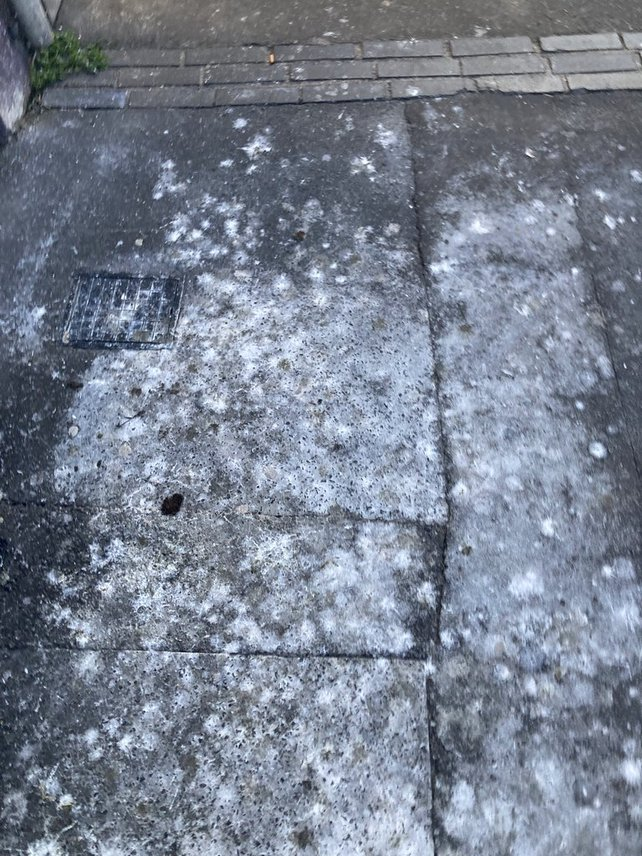
Seo mar a bha an cabhsair air feadh air feadh meadhan Lowestoft!
Mar sin, bha mi toilichte fhaighinn a-mach à meadhan a’ bhaile agus tron bhaile gu Carlton Colville dìreach taobh a-muigh a’ bhaile far a bheil an taigh-tasgaidh.
Agus abair gur e taigh-tasgaidh snog a th’ ann.
Ma tha thu air a bhith ann an Taigh-tasgaidh Nàiseanta nan Tramaichean ann an Crich, Schd Derby, no ann an Taigh-tasgaidh nam Busaichean-tràilidh ann an Sandtoft, tha e gu math coltach ri sin oir a bharrachd air buill-taisbeanaidh còmhdhail, tha bùth ann den t-seòrsa a chitheadh tu ann an linn nan tramaichean, a bharrachd air pàirce bheag, garaiste le seann chàraichean agus oifis-phuist bheag. Tha clachan-chàsaidh – cobbles – air an rathad cuideachd.
Tha trì siostaman còmhdhail eadar-dhealaichte san taigh-tasgaidh. Sa chiad dol a-mach, tha an trama. Tha loidhne ghoirid ann a tha direach. Airson adhbhar air choireigin, cha robh an t-slighe air fad fosgailte, ach chòrd e rium a dhol air trama Blackpool air na bha air fosgailte den loidhne. An uair sin, tha busaichean tràilidh ann agus tha iad a’ ruith ann an cearcall timcheall air an taigh-tasgaidh, seachad air depot nan tramaichiean is nan tràilidhean.
Chan eil ach trì àiteachan ann am Breatainn far an urrainn dhut a dhol air bus-tràilidh – Sandtoft (faisg air Doncaster – taigh-tasgaidh naiseanta nam busaichean-tràilidh), East Anglia Transport Museum agus am Black Country Living Museum ann an Dudley. Agus tha busaichean-tràilidh gu bhith a’ ruith ann am Beamish anns an North of England Living Museum latha de na làithean cuideachd.
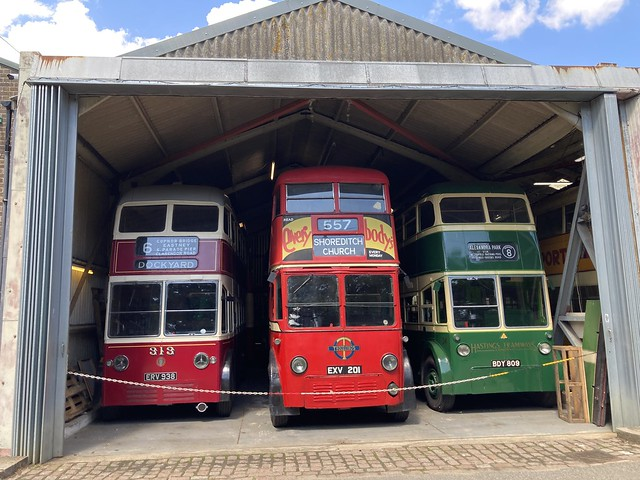
(Seada nan tràilidhean: Portsmouth, Lunnainn agus Hastings)
Tha mi air leth measail air na tràilidhean agus an turas seo, gu sònraichte, bha e math a dhol air bus-tràilidh à Suffolk fhein – a Ipswich. Tha deagh chruinneachadh de thramaichean is de bhusaichean-tràilidh a diofar àiteachan agus a bharrachd air Suffolk fhein, tha gu leòr ann à Lunnainn – baile mòr nan tramaichean is nam busaichean-tràilidh.
Mu dheireadh, tha Rathad-iarainn Aotrom Suffolk an Ear ann, a tha na rathad-iarainn caol-ghèidse den t-seòrsa a bha cumanta aig factaraidean is cuairidhean uair.
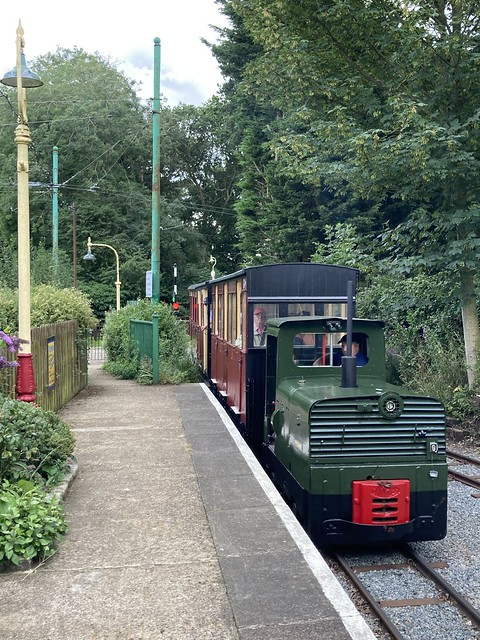
East Suffolk Light Railway
Mholainn an Taigh-tasgaidh seo gu mòr – tha e beag agus tha e gu math fada air falbh à Alba ach tha iad air tòrr mòr a dhèanamh leis an làraich bhig a th’ aca – agus tha planaichean mòra aca aig an àm seo gus an taigh-tasgaidh a leudachadh.
Tha Suffolk sgoinneil – ach thoir an aire do na faoilleagan!
Alasdair
Air m’ fhòn: Status Quo “Whatever You Want” (1979), 9/10.
Tadhail air Trèanaichean, tramaichean is tràilidhean
Powered by WPeMatico
Le Gordon Wells
Here at Island Voices/Guthan nan Eilean we’re delighted to host a first blogpost from Mary Morrison, the co-ordinator and guiding light at Comann Eachdraidh Uibhist a Tuath (CEUT) for the “Aire air Sunnd” wellbeing project, supported by the Ideas Fund. And we look forward to further contributions!
Picture: Intergenerational walkers and talkers exploring Gaelic heritage between Barpa Langais and Pobul Fhinn as part of the Aire air Sunnd “Fèis Shamhraidh” (summer festival)
My first post – latha math a h-uile duine!
This is the first attempt at a blogpost – a way of trying to convey what’s happening in our ‘Aire air Sunnd’ project, (Attention to Cheerfulness), from the CEUT co-ordinating perspective. Over the past eighteen months I have been trying to make sense of some ideas that have been buzzing at the edges of my mind, and coming very gradually to understand the areas we need to discuss where we as a project might go next; (I think it was poet Marianne Moore who said, ‘Thought collects in pools’).
We are hoping that North Uist friends and relations will join in these ‘citizen science’ conversations and help push our community’s (or communities’) ideas further. Particularly we need to work out how the project findings can help, first practically, in raising funding to refurbish Sgoil Chàirinis, and second, in gathering evidence convincing enough to make our voices challenge and reverberate at local and national public policy levels.
During a recent recorded forum between Comann Eachdraidh Uibhist a Tuath and our three university research partners, Iain Campbell from the Language Sciences Institute, University of the Highlands and Islands, asked three provocative questions, which I paraphrase as ‘how do you define a single community, how could such a community be said to be representative and how could it develop agency, make its voice heard in places of power, to make a difference?
Suddenly Iain had provided a scaffold for my scattered reflections – thank you, Iain.
Our small CEUT wellbeing group, facilitated by Jess Wood (working with Heather Morgan of Aberdeen University’s Applied Health Sciences department), met for a series of workshops last year. An open call to CEUT members resulted in ten of us gathering at Sgoil Chàirinis, where we were encouraged by Jess to figure out which aspects of local heritage and wellbeing mattered most to us. We were a mix of long term Gaelic speaking Uisteachs, Uist returners and some who had chosen to settle here and had lived here for over twelve years, with all of us acknowledging the Gaelic language as the pulse or heartbeat of our small, remote island community.
‘The assimilation of traditional communities is not a simple matter of painlessly extracting one language and culture and transplanting in an inherently superior replacement; the process can induce breaks in generations between families, discontinuities in a community’s sense of place and self- confidence and fractures in a person’s identity….’ (Michael Newton, Warriors of the Word)
What seemed to matter most to our group at its first workshop, in no order of preference, were:
Working alongside our researchers, we began the process of constructing a survey of our members last winter, to learn more about how these choices can support our communities’ wellbeing, especially after the wearisomely long and anxious period of the pandemic. (CEUT had already recorded aspects of the resilience of different age groups across the island during this period). It was interesting to see and archive, at the end of 2021, how much comfort our community had found in ‘closer family relationships’, the ‘local environment’, and ‘being creative’ as ways of overcoming the isolation and potential loneliness of lockdown.
The main highlights of the Aire air Sunnd survey findings were:
Perhaps the time has come now for CEUT:
The recently revived Horizon programme, (previously denied to British citizens post-Brexit, but still a major plank supporting the EU’s academic programmes), defines co-creation as ‘a guarantee of the growth of citizen science and innovation in providing public services’. In this project we, CEUT, as the instigators and funded body, acknowledge that it has taken us time to recognise our assets, the importance of our local language and traditional cultural knowledge, as we have worked alongside our researchers. It is imperative now to build on these strengths, resisting any attempts to ‘colonise’ us in ways that do not result in mutual benefits to researchers and CEUT alike. CEUT also needs to find routes for our endeavours to connect with and influence public services. Dr Victoria Rawlings, in her co-authored publication, ‘Community -led research: Walking New Paths Together’, even suggests that ‘community -led research produces better quality research, a better, more fulfilling experience for its participants and more reliable research outcomes’.
We need to gather evidence of what works well locally, for whom, in what settings /contexts and how these can best be supported in such parlous times of fiscal, social and planetary challenge.
Please join in this community discussion! Do add your thoughts, the more random the more inspirational!
Mary Morrison
Comments are welcome, here on this blogpost, or perhaps on the CEUT or Island Voices Facebook pages or Twitter feeds if that’s where you see it first. All platforms will be monitored and all contributions valued!
Tadhail air Island Voices – Guthan nan Eilean
Powered by WPeMatico
Bana-ghaisgeach nan cuantan, Grace Darling
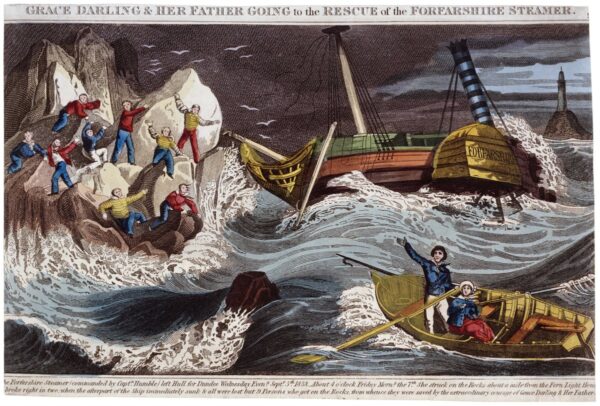
O chionn 185 bliadhna air an 7 latha den t-Sultain shàbhail Grace Darling agus a h-athair naoinear às an long-bhriste HMS Forfarshire. Mar bhana-ghaisgeach na mara tha e iomchaidh gum bi cuimhne againn oirre nar coimhearsnachd chladaich air an ceann-là seo.
Rugadh Grace ann an 1815 ann an Northumberland, mar nighean neach-taigh-sholais, agus ann an 1838 bha Grace a’ fuireach còmla ris agus a màthair anns an taigh-solais Eilean Longstone, air fear de na h-Eileanan Farne. Bha Grace 22 aig an àm sin agus a’ cuideachadh le obair an taighe agus an taigh-sholais, nam measg le cumail faire.
Sna h-uairean tràtha den 7 den t-Sultain, a bha gu sònraichte stoirmeil, chunnaic Grace briseadh-luing eagalach bho uinneag an t-seòmair-chadail aice – bhuail bàta-smùide eilean ìosal creagach, Big Harcar Rock, mu mhìle air falbh, agus bhris na dhà leth. Thachair sin mu 4 uairean sa mhadainn. Ruith i dhan phrosbaig feuch am faiceadh i duine beò sam bith, ach bha e fathast ro dhorcha, ach an ceann ùine dh’aithnich iad daoine air a chreig. Cho-dhùin Mgr Darling agus Grace gun iomraicheadh iad an sin, a dh’aindeoin staid uabhasach na sìde ‘s na mara, gus feuchainn ri na truaghanan a shàbhaladh. Bha fios aca gum biodh sin na bu luaithe na feitheamh air a’ bhàta-teasairginn à Seahouses (e fhèin bàta-ràmh), nach toisicheadh idir, ‘s dòcha, leis an t-sìde ‘s an astar na bu mhotha.
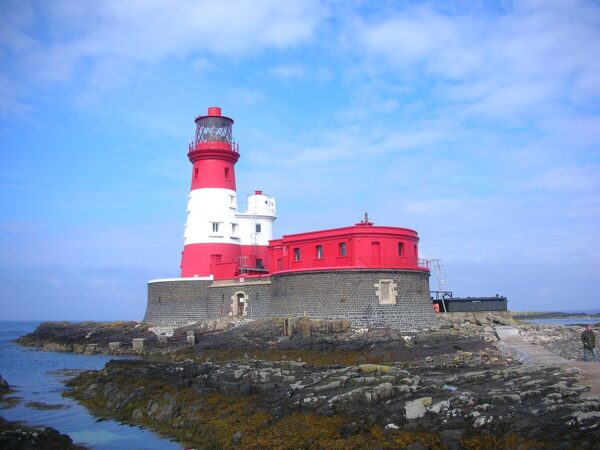
Às dèidh saothrach anabarraich, chaidh aca air an copal aca a stiùreadh dhan àite, far an deach Mgr Darling suas air a’ chreig a’ fàgail Grace na h-aonar a’ cumail am bàta faisg air làimh sa mhuir fhiadhaich ‘s san stoirm fheargach. Lorg iad naoinear luchd-teasairginn, cus rim toirt dhan taigh-sholais ann an aon bhaidse. Dh’iomair iad a’ chiad fheadhainn air ais – boireannach, fear air a ghoirteachadh, agus triùir den chriutha, agus an uair sin dh’iomair Mgr Darling agus an criutha air ais airson chàich. Dh’fhuirich Grace san taigh-sholais gus coimheadh às dèidh an fhir lèonta agus a’ bhoireannaich, a chaill dithis cloinne san tubaist. Ro 9 uair sa mhadainn bha a h-uile naoinear sàbhailte ann an Longstone.
Bha an HMS Forfarshire air an t-slighe bho Hull gu Dùn Dèagh le 62 daoine air bòrd. Bha na goileadairean air am fàilneachadh agus mar sin bha an t-einnsean gun fheum, agus cha robh aig a’ chaiptean ach nàdar de sheòl ri chleachdadh san stoirm. Shaoil e am mearachd gur e taigh-solais Inner Farne a bh’ anns an Longstone agus dhrioft am bàta-smùide air an eilean chreagach neo-fhaicsinneach. Bhrìs an long na dà leth, agus ron ghlasadh an latha cha mhòr nach robh e air a dhol fodha. Chaidh aig naoinear eile air teicheadh anns a’ bhata-teasairginn aig an long fhèin agus chaidh an sàbhaladh le long eile san dol seachad. Chaidh na cuirp-chloinne a lorg cuideachd leis a’ bhàta-teasairginn à Seahouses (is bràthair Grace air aon de na ràimh). B’ feudar dhan bhàta sin cuideachd feitheamh fad 3 làithean aig taigh-solais Longstone air sgàth na sìde.
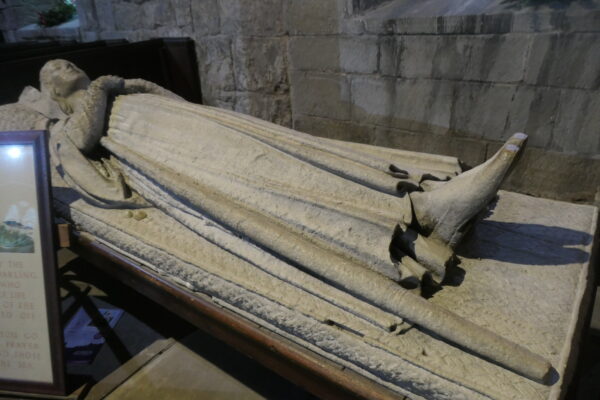
Nuair a nochd an naidheachd, chaidh Grace na bana-ghaisgeach chliùiteach air feadh na dùthcha. Fhuair i urraman, duaisean (nam measg £50 bho Bhanrìgh Bhictoria!), agus fiù ‘s tairgsean-pòsaidh. Chaidh bàrdachd is òrain a sgrìobhadh mu a deidhinn agus chaidh iomadh portraid a pheantadh. Gu mi-fhortamach ge-tà, cha robh mòran ùine air fhagail dhi gus tlachd a ghabhail na cliù (ma ghabh idir) – chaochail i leis a’ chaitheamh dìreach 4 bliadhna às dèidh sin. Thàinig na ceudan dhan tiodhlacadh ann am Bamburgh, far a bheil carragh-chuimhne brèagha san chladh aig eaglais eachdraidheil Naomh Aodhan, agus tha an iomhaigh-chloiche shnaithte àlainn a bha air an tuama aice air a gleidheadh am broinn na h-eaglais. Bha cothrom agam tadhal orra nuair a bha mi ann an Northumberland an-uiridh. Tha taigh-tasgaidh RNLI Grace Darling ann am Bamburgh cuideachd. https://rnli.org/find-my-nearest/museums/grace-darling-in-10-objects
Tha bana-ghaisgeach iomraidh againne ann am Machair Rois cuideachd – Oighrig an Dà Raimh; cuimhnichean, còmhla ri dìleab shònraichte Grace, gun do chluich na boireannaich cuideachd riamh am pàirt ann am dràma nan cuantan.
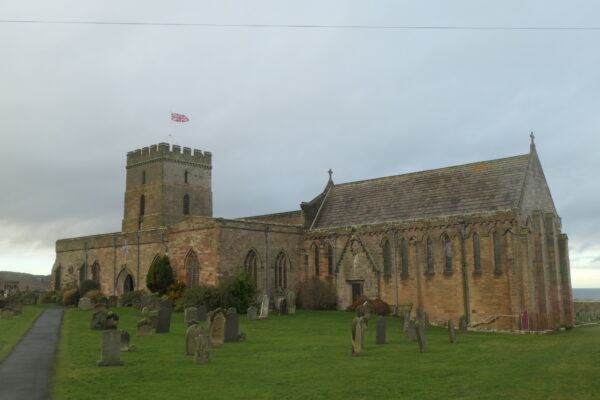
++++++++++++++++++++++++++++++++++++++++++++++++++++++++
Maritime heroine, Grace Darling
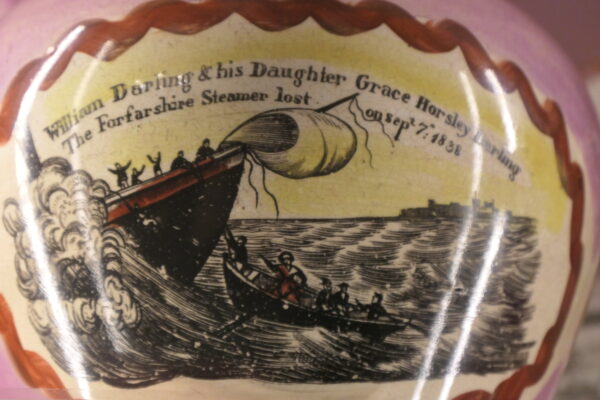
On 7 September it will be 185 years since Grace Darling and her father saved the lives of nine souls from the wrecked HMS Forfarshire. As a maritime heroine, it’s fitting for our coastal community to remember her on this anniversary.
Grace was born in 1815 in Northumberland, daughter of a lighthouse-keeper, and in 1899 Grace and her mother were living with him in Longstone Island lighthouse, one on of the Farne Islands. Grace was 22 then, and helping with household and lighthouse duties, including taking turns at watch.
In the exceptionally stormy night to 7 September Grace saw from her bedroom window a terrible wreck happening – a steamship hit a low rocky island, Big Harcar Rock, about a mile away, and broke in two. This happened about 4am. She ran to the lighthouse telescope to see if she could spot survivors but it was still too dark, but eventually they could make out some people on the rock. Mr Darling and Grace decided to row there, despite the dreadful conditions, and try to rescue them – they knew that would be quicker than waiting for the lifeboat (also a rowing boat) from more distant Seahouses, which might not even have launched due to the weather conditions and distance.
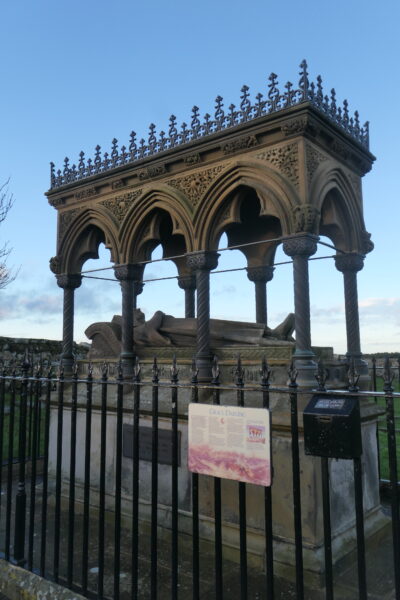
With immense effort, the two of them managed to get their coble to the scene, Grace on her own holding the boat steady in the raging waters and storm while her father went onto the rock. They discovered nine survivors, too many for one trip back to the lighthouse. They brought back the first batch, a woman, an injured man, and three crewmen to Longstone, and then Mr Darling and the crewmen rowed back to get the remaining survivors while Grace and her mother tended the injured man and the woman, whose two children had been lost. By 9am all nine were safely at the lighthouse.
The ship was the HMS Forfarshire, en route from Hull to Dundee with 62 people on board. The ship’s boilers had failed, so the engine was useless, and the captain only had a makeshift sail to use in the storm. He mistook the Longstone light for the Inner Farne one, and drifted onto the unseen rocky island. The ship broke in two, and by morning was almost completely sunk. Nine other people had managed to board the ship’s lifeboat and were later picked up by a passing ship – all others were lost. The two drowned children’s bodies were also picked up later by the Seahouses lifeboat (with Grace’s brother on one of the oars). That lifeboat also had to shelter at the lighthouse for 3 days because of the weather.
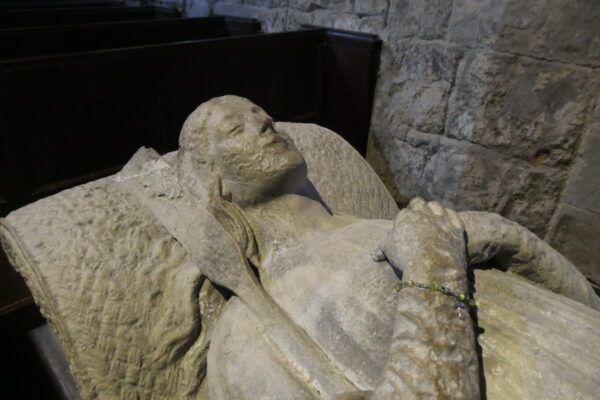
Once the news broke, Grace was celebrated as a heroine throughout the land. She received honours, rewards (including £50 from Queen Victoria!), and even proposals of marriage. Poems and songs were written about her and her portrait was freqently painted. Sadly, however, she didn’t live long to enjoy the admiration (if indeed she did) – she died of tuberculosis only four years later. Crowds turned out for her funeral in Bamburgh, where she has an ornate monument in the churchyard of historic St Aidan’s Church, and the beautiful recumbent carving from her tomb is now preserved inside the church. I was able to visit them while in Northumberland last year. There is also a RNLI Grace Darling Museum in Bamburgh : https://rnli.org/find-my-nearest/museums/grace-darling-in-10-objects
On the Seaboard we also have our rowing heroine – Effie of the Two Oars; a reminder, along with Grace’s remarkable legacy, that women too have always played their part in the drama of the seas.
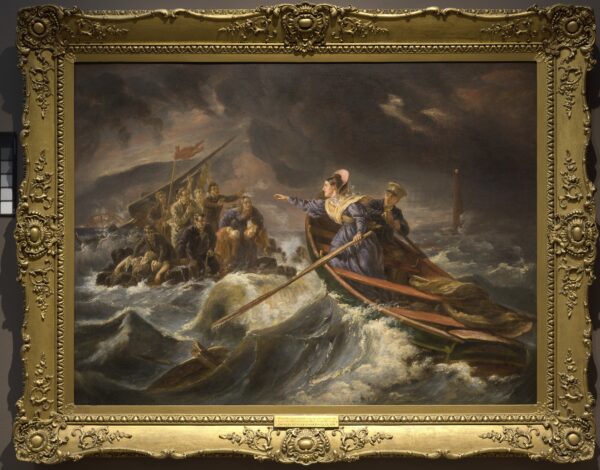
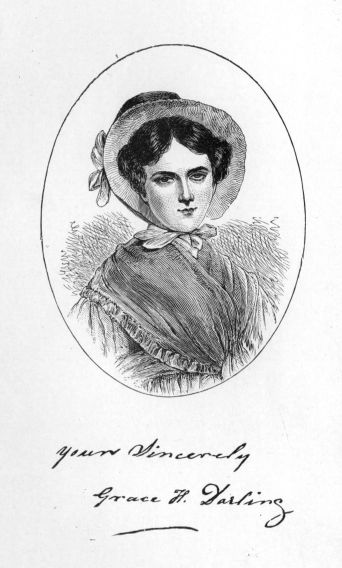

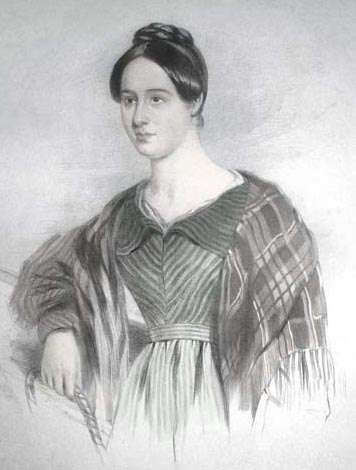
Tadhail air seaboardgàidhlig
Powered by WPeMatico
Le Gordon Wells
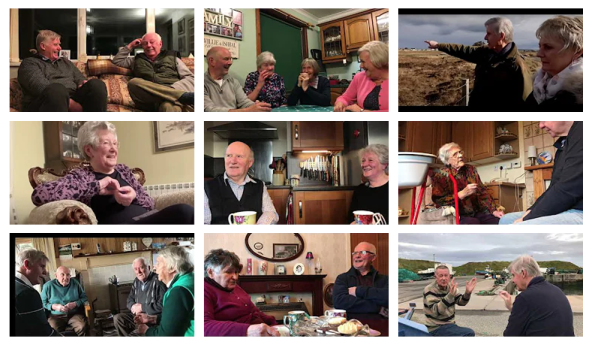 Comann Eachdraidh Sgìre Bhac have been busy recently, placing translatable subtitles on more of their videos. It’s only a year since the first one went up – A Tour of Upper Coll/Cuairt Chuil Uaraich – with Coinneach MacÌomhair and Maighread Stiùbhart.
Comann Eachdraidh Sgìre Bhac have been busy recently, placing translatable subtitles on more of their videos. It’s only a year since the first one went up – A Tour of Upper Coll/Cuairt Chuil Uaraich – with Coinneach MacÌomhair and Maighread Stiùbhart.
Now, with the help of Comhairle nan Eilean Siar and the Western Isles Development Trust, student placement Ellie MacDonald has added another 8 videos to the subtitled archive. That’s a substantial piece of work which deserves hearty congratulations!
You can now view the “box set” in this dedicated playlist:
There are hours of fascinating discussion and reminiscence there. And learners or non-speakers of Gaelic can also follow the conversations with the help of the subtitles, not to mention the option of slowing down the speed of the video to help you catch what’s being said, using the YouTube Settings wheel.
Mealaibh ur naidheachd, a chàirdean!
Tadhail air Island Voices – Guthan nan Eilean
Powered by WPeMatico
Le Gordon Wells
 The second Digital Fèis for Aire air Sunnd is now scheduled for 11th and 12th August, taking the place of the May event which had to be postponed. Here’s the updated programme. Island Voices will be represented again, with new video playlists, and there will be additional Gaelic representation from the “Gaelic Crisis” writing team in the interdisciplinary forum on the Friday.
The second Digital Fèis for Aire air Sunnd is now scheduled for 11th and 12th August, taking the place of the May event which had to be postponed. Here’s the updated programme. Island Voices will be represented again, with new video playlists, and there will be additional Gaelic representation from the “Gaelic Crisis” writing team in the interdisciplinary forum on the Friday.
Tadhail air Island Voices – Guthan nan Eilean
Powered by WPeMatico
Tadhail air Blog Pàrlamaid na h-Alba
Powered by WPeMatico